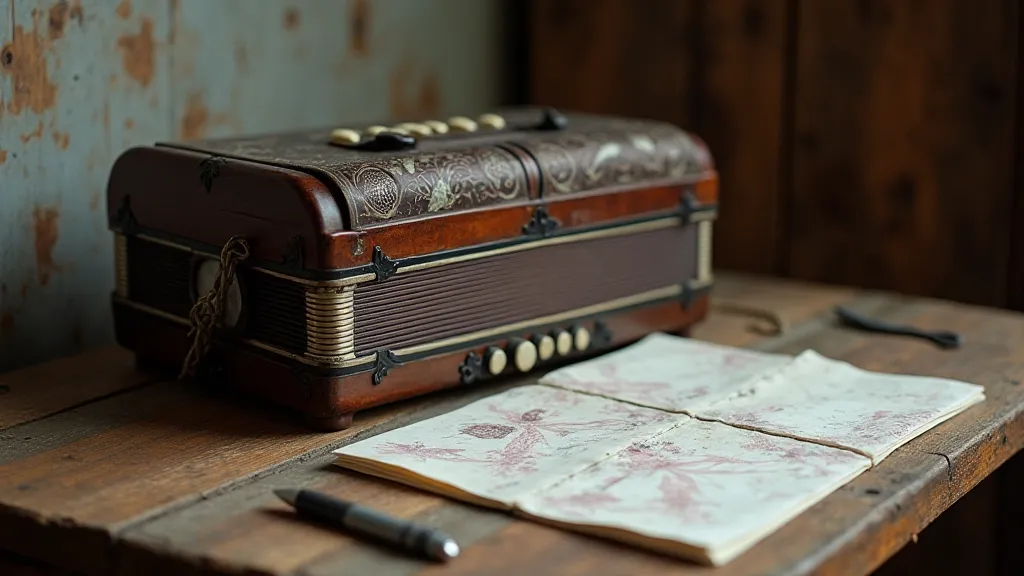Ink and Intuition: Trusting the Unseen in Your Creative Journey
There's a particular kind of melancholy beauty found in objects that have lived a life. A well-worn leather-bound book, a chipped ceramic bowl, a tarnished silver locket – they whisper stories of hands that held them, moments they witnessed, and a passage of time that inevitably leaves its mark. Lately, that feeling has been especially poignant for me, sparked by a newly acquired antique accordion. Its bellows, once vibrant with music, now sigh with a quiet breath, its keys possess a subtle unevenness that speaks of countless performances. It’s an instrument that resists precise control, demanding instead a willingness to surrender to its unique quirks. That surrender, I’m realizing, resonates deeply with the art of paper marbling.

The Dance of Color: Introducing Paper Marbling
Paper marbling, at its core, is an art of letting go. It’s a mesmerizing process where pigment is floated on a thickened water bath, manipulated with tools to create intricate patterns, and then carefully transferred to paper. The result isn’t planned; it’s a collaboration between artist and medium, a conversation between intention and chance. It's a craft older than many imagine. While techniques vary across cultures—from the Japanese *Edo Sumi-e* to Turkish *Ebru* and European decorative paper making—the underlying principle remains the same: to create unique, one-of-a-kind works through controlled chaos.
Historically, marbled paper wasn't considered a “fine art” in the traditional sense. It served a practical purpose—beautifully decorating book covers, stationery, and wrapping papers – a luxurious touch in a world where elegance often involved handcrafted details. Think of the lavishly marbled endpapers in antique books, a subtle indulgence that elevated the overall aesthetic. The rise of industrial printing gradually diminished its widespread use, but the resurgence of interest in handcrafted objects has breathed new life into the practice. Suddenly, marbling isn’t just a decorative element; it's a statement of individuality, a tangible connection to a tradition of artistry.
The Intuitive Process: More Than Just Technique
The technical aspects of paper marbling – the choice of sizing agents, the careful blending of pigments, the specific tools used for manipulation – are important, certainly. But the true magic lies beyond the mechanics. It's in that moment when you release the pigment into the bath, when you introduce a tool – a rake, a comb, a stylus – and watch as the colors swirl and blend in unpredictable ways. It’s then that you have to trust your instincts. Do you add more color? Do you disturb the surface? Do you leave it alone?
There's a vulnerability in that surrender. You’re relinquishing control, acknowledging that the final product will be something you couldn't have entirely predicted. This resonates deeply with writing, I find. So often, we try to plan every sentence, to meticulously craft a narrative arc. But sometimes, the most powerful moments arise from unexpected turns, from allowing the story to lead you down unforeseen paths. Just as a marbler might be surprised by a vibrant vein of color emerging from a subtle movement, a writer can be transformed by a sudden shift in perspective or a character revealing an unexpected truth.
The antique accordion, with its resistance to precise control, has reminded me of this. When I first tried to play it, the notes weren’t always what I intended. But instead of fighting against that quirkiness, I began to embrace it. The unexpected bends and hesitations added a layer of character, a soulful depth that wouldn’t have been there otherwise. And that's exactly what happens with paper marbling; the "imperfections" are the fingerprints of the process, the visible signs of a unique creative journey.
Craftsmanship and Preservation: A Shared Respect for History
There's a growing appreciation for craftsmanship – for objects made by hand, with care and attention to detail. We crave authenticity in a world saturated with mass-produced goods. The paper marbling community reflects this sentiment. Many contemporary marblers are dedicated to using traditional materials and techniques, ensuring that the practice remains true to its historical roots. They meticulously recreate historic patterns, studying antique samples to understand the nuances of the process.
The same holds true for the restoration of antique instruments like my accordion. The process isn’s about erasing the passage of time; it’s about stabilizing the instrument, preserving its integrity, and allowing its history to shine through. A skilled restorer understands that the cracks, the worn leather, the faded varnish – these are all part of the object’s story. They’re visible reminders of the hands that have held it, the music it has played, and the life it has lived.

Beyond the Surface: Embracing the Unexpected
The beauty of both paper marbling and writing lies in the willingness to embrace the unexpected. To surrender to the process, to trust your instincts, and to allow the work to evolve organically. It's a lesson that extends far beyond the studio or the writing desk. It's a reminder that life itself is full of surprises, and that the most rewarding experiences often arise from letting go of control and allowing ourselves to be guided by intuition.
Consider the antique accordion again. It's more than just an instrument; it's a tangible link to the past, a reminder of the enduring power of human creativity. It's a metaphor for the artistic journey itself – a process of surrender, experimentation, and ultimately, discovery. And just as the swirls of pigment on a sheet of marbled paper reveal a unique and unexpected beauty, so too can the unexpected twists and turns of life lead us to a deeper understanding of ourselves and the world around us.

The next time you approach a blank sheet of paper, or a daunting writing assignment, remember the lesson of the antique accordion, the dance of the pigments, the silent wisdom of the past. Trust your intuition. Embrace the unexpected. And allow the process to lead you to a place you couldn't have imagined.





